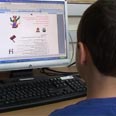
Illustration
Photo: Dalit Shacham
The OECD published an unsettling report on Israeli education Monday, bringing to light the fact that though the state considers itself a high-tech empire of sorts, its schools are worryingly underequipped with technology.
Of the 64 countries surveyed by the global organization, Israel was in 49th place in student-to-computer ratio. Similarly to most education issues in Israel, there is also a large gap between schools of different socio-economic status.
More Discrimination?
Arab university students claim ministry awards scholarships to Druze, Circassians but not to Muslims
The ratio between students to computers is currently 0.37, similarly to that which exists in countries like Trinidad and Tobago, Uruguay, Panama, and Albania, and far less than in countries such as New Zealand (1.16), Australia (1.02), the US (0.91) and Germany (0.6).
The Knesset Education Committee ordered the retrieval of data in honor of a special debate set to take place Monday morning. The Knesset Research and Information Center explains that worldwide surveys show students tend to achieve more with computers in nearly all subjects – including literacy and mathematics.
The research center also published an Education Ministry plan from 1993, in which the goal was to supply each student with a computer. In 2000 the plan was re-launched with the aim of supplying a computer for every five students in Israel.
But even "computer friendly" schools, of which there are 1,509 belonging to the Education Ministry, have a computer-to-student ratio of just 1:10, and 36,225 additional computers are needed.
In schools of lower socio-economic status, especially in the Arab sector, conditions are far worse. For example, in Tel Aviv the ratio is 7.2, while in Umm al-Fahm it is 25.9.
Researchers who conducted the survey wrote in their conclusion that the government should consider earmarking funds for the closing of the gap between the Jewish and Arab sectors.
- Follow Ynetnews on Facebook















